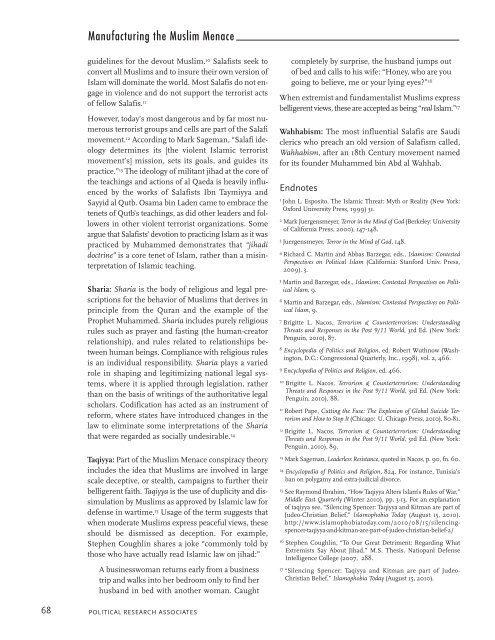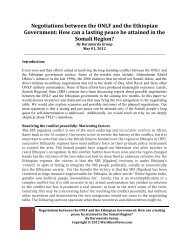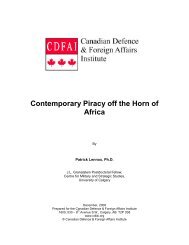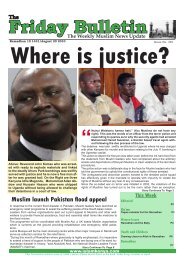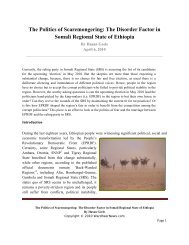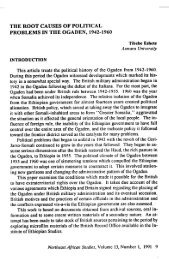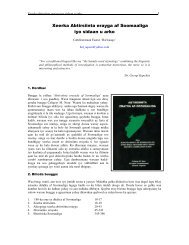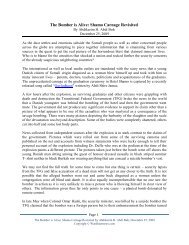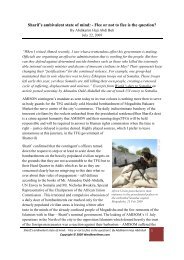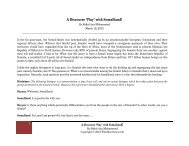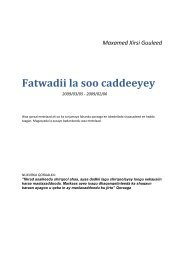Manufacturing the Muslim Menace - Political Research Associates
Manufacturing the Muslim Menace - Political Research Associates
Manufacturing the Muslim Menace - Political Research Associates
You also want an ePaper? Increase the reach of your titles
YUMPU automatically turns print PDFs into web optimized ePapers that Google loves.
<strong>Manufacturing</strong> <strong>the</strong> <strong>Muslim</strong> <strong>Menace</strong><br />
guidelines for <strong>the</strong> devout <strong>Muslim</strong>. 10 Salafists seek to<br />
convert all <strong>Muslim</strong>s and to insure <strong>the</strong>ir own version of<br />
Islam will dominate <strong>the</strong> world. Most Salafis do not engage<br />
in violence and do not support <strong>the</strong> terrorist acts<br />
of fellow Salafis. 11<br />
However, today’s most dangerous and by far most numerous<br />
terrorist groups and cells are part of <strong>the</strong> Salafi<br />
movement. 12 According to Mark Sageman, “Salafi ideology<br />
determines its [<strong>the</strong> violent Islamic terrorist<br />
movement’s] mission, sets its goals, and guides its<br />
practice.” 13 The ideology of militant jihad at <strong>the</strong> core of<br />
<strong>the</strong> teachings and actions of al Qaeda is heavily influenced<br />
by <strong>the</strong> works of Salafists Ibn Taymiyya and<br />
Sayyid al Qutb. Osama bin Laden came to embrace <strong>the</strong><br />
tenets of Qutb’s teachings, as did o<strong>the</strong>r leaders and followers<br />
in o<strong>the</strong>r violent terrorist organizations. Some<br />
argue that Salafists’ devotion to practicing Islam as it was<br />
practiced by Muhammed demonstrates that “jihadi<br />
doctrine” is a core tenet of Islam, ra<strong>the</strong>r than a misinterpretation<br />
of Islamic teaching.<br />
Sharia: Sharia is <strong>the</strong> body of religious and legal prescriptions<br />
for <strong>the</strong> behavior of <strong>Muslim</strong>s that derives in<br />
principle from <strong>the</strong> Quran and <strong>the</strong> example of <strong>the</strong><br />
Prophet Muhammed. Sharia includes purely religious<br />
rules such as prayer and fasting (<strong>the</strong> human-creator<br />
relationship), and rules related to relationships between<br />
human beings. Compliance with religious rules<br />
is an individual responsibility. Sharia plays a varied<br />
role in shaping and legitimizing national legal systems,<br />
where it is applied through legislation, ra<strong>the</strong>r<br />
than on <strong>the</strong> basis of writings of <strong>the</strong> authoritative legal<br />
scholars. Codification has acted as an instrument of<br />
reform, where states have introduced changes in <strong>the</strong><br />
law to eliminate some interpretations of <strong>the</strong> Sharia<br />
that were regarded as socially undesirable. 14<br />
Taqiyya: Part of <strong>the</strong> <strong>Muslim</strong> <strong>Menace</strong> conspiracy <strong>the</strong>ory<br />
includes <strong>the</strong> idea that <strong>Muslim</strong>s are involved in large<br />
scale deceptive, or stealth, campaigns to fur<strong>the</strong>r <strong>the</strong>ir<br />
belligerent faith. Taqiyya is <strong>the</strong> use of duplicity and dissimulation<br />
by <strong>Muslim</strong>s as approved by Islamic law for<br />
defense in wartime. 15 Usage of <strong>the</strong> term suggests that<br />
when moderate <strong>Muslim</strong>s express peaceful views, <strong>the</strong>se<br />
should be dismissed as deception. For example,<br />
Stephen Coughlin shares a joke “commonly told by<br />
those who have actually read Islamic law on jihad:”<br />
A businesswoman returns early from a business<br />
trip and walks into her bedroom only to find her<br />
husband in bed with ano<strong>the</strong>r woman. Caught<br />
68 POLITICAL RESEARCH ASSOCIATES<br />
completely by surprise, <strong>the</strong> husband jumps out<br />
of bed and calls to his wife: “Honey, who are you<br />
going to believe, me or your lying eyes?” 16<br />
When extremist and fundamentalist <strong>Muslim</strong>s express<br />
belligerent views, <strong>the</strong>se are accepted as being “real Islam.” 17<br />
Wahhabism: The most influential Salafis are Saudi<br />
clerics who preach an old version of Salafism called,<br />
Wahhabism, after an 18th Century movement named<br />
for its founder Muhammed bin Abd al Wahhab.<br />
Endnotes<br />
1 John L. Esposito, The Islamic Threat: Myth or Reality (New York:<br />
Oxford University Press, 1999) 31.<br />
2 Mark Juergensmeyer, Terror in <strong>the</strong> Mind of God (Berkeley: University<br />
of California Press, 2000), 147-148.<br />
3 Juergensmeyer, Terror in <strong>the</strong> Mind of God, 148.<br />
4 Richard C. Martin and Abbas Barzegar, eds., Islamism: Contested<br />
Perspectives on <strong>Political</strong> Islam (California: Stanford Univ. Press,<br />
2009), 3.<br />
5 Martin and Barzegar, eds., Islamism: Contested Perspectives on <strong>Political</strong><br />
Islam, 9.<br />
6 Martin and Barzegar, eds., Islamism: Contested Perspectives on <strong>Political</strong><br />
Islam, 9.<br />
7 Brigitte L. Nacos, Terrorism & Counterterrorism: Understanding<br />
Threats and Responses in <strong>the</strong> Post 9/11 World, 3rd Ed. (New York:<br />
Penguin, 2010), 87.<br />
8 Encyclopedia of Politics and Religion, ed. Robert Wuthnow (Washington,<br />
D.C.: Congressional Quarterly, Inc., 1998), vol. 2, 466.<br />
9 Encyclopedia of Politics and Religion, ed. 466.<br />
10 Brigitte L. Nacos, Terrorism & Counterterrorism: Understanding<br />
Threats and Responses in <strong>the</strong> Post 9/11 World, 3rd Ed. (New York:<br />
Penguin, 2010), 88.<br />
11 Robert Pape, Cutting <strong>the</strong> Fuse: The Explosion of Global Suicide Terrorism<br />
and How to Stop It (Chicago: U. Chicago Press, 2010), 80-81.<br />
12 Brigitte L. Nacos, Terrorism & Counterterrorism: Understanding<br />
Threats and Responses in <strong>the</strong> Post 9/11 World, 3rd Ed. (New York:<br />
Penguin, 2010), 89.<br />
13 Mark Sageman, Leaderless Resistance, quoted in Nacos, p. 90, fn. 60.<br />
14 Encyclopedia of Politics and Religion, 824. For instance, Tunisia’s<br />
ban on polygamy and extra-judicial divorce.<br />
15 See Raymond Ibrahim, “How Taqiyya Alters Islam’s Rules of War,”<br />
Middle East Quarterly (Winter 2010), pp. 3-13. For an explanation<br />
of taqiyya see, “Silencing Spencer: Taqiyya and Kitman are part of<br />
Judeo-Christian Belief,” Islamophobia Today (August 15, 2010).<br />
http://www.islamophobiatoday.com/2010/08/15/silencingspencer-taqiyya-and-kitman-are-part-of-judeo-christian-belief-2/<br />
16 Stephen Coughlin, “To Our Great Detriment: Regarding What<br />
Extremists Say About Jihad,” M.S. Thesis. Natiopanl Defense<br />
Intelligence College (2007, 288.<br />
17 “Silencing Spencer: Taqiyya and Kitman are part of Judeo-<br />
Christian Belief,” Islamophobia Today (August 15, 2010).


